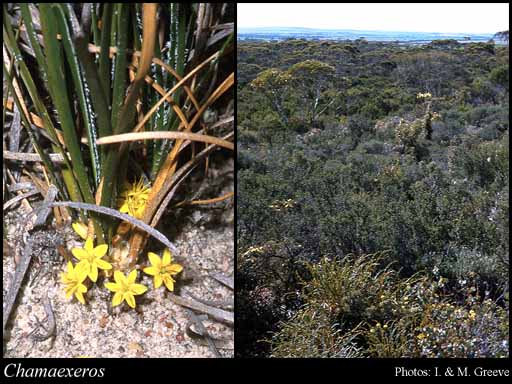- Reference
- Fl.Austral. 7:110 (1878)
- Name Status
- Current

Scientific Description
Family Dasypogonaceae.
Habit and leaf form. Herbs (medium, caespitose, tufted). Perennial (graminoid habit). Leaves basal. Plants with a basal concentration of leaves (more or less acaulescent), or with neither basal nor terminal concentrations of leaves; rhizomatous (short). Pachycaul. Mesophytic, or xerophytic. Leaves small to large; alternate (or ‘indeterminate’: crowded, terminal rosette, dense 2-ranked tufts); spiral, or distichous; leathery, or modified into spines, or ‘herbaceous’; sessile; sheathing. Leaf sheaths not tubular; with free margins. Leaves simple. Leaf blades entire; flat; acicular, or linear; linear (gradually tapered to the apex); parallel-veined; without cross-venules; sheathing. Leaves without stipules. Leaf blade margins scarious and often becoming lacerated, or white membranous, or fimbriate. Vegetative anatomy. Plants without silica bodies. Leaf anatomy. Hairs absent. Extra-floral nectaries absent. Stem anatomy. Secondary thickening absent.
Reproductive type, pollination. Fertile flowers hermaphrodite. Unisexual flowers absent. Plants hermaphrodite.
Inflorescence and flower features. Flowers aggregated in ‘inflorescences’; in cymes, or in panicles. Inflorescences scapiflorous, or not scapiflorous; axillary; cymose panicles. Flowers pedicellate; bracteate (short, imbricate, scarious); ebracteolate; small; regular; 3 merous; cyclic; pentacyclic. Perigone tube present, or absent. Hypogynous disk absent. Perianth of ‘tepals’; 6; 2 -whorled; isomerous; petaloid; similar in the two whorls, or different in the two whorls; cream, or yellow; fleshy, or non-fleshy. Androecial members definite in number. Androecium 6. Androecial members free of the perianth, or adnate (adnate to the base of the perianth); all equal; free of one another; 2 -whorled. Androecium exclusively of fertile stamens. Stamens 6 (in 2 whorls); all more or less similar in shape; diplostemonous; 3 hypogynous and alternate with the inner segments, 3 on inner segments. Anthers dorsifixed; versatile; dehiscing via longitudinal slits; introrse. Pollen shed as single grains. Gynoecium 3 carpelled. The pistil 3 celled. Carpels isomerous with the perianth. Gynoecium syncarpous; eu-syncarpous; superior. Ovary plurilocular; 3 locular. Gynoecium stylate. Styles 1; attenuate from the ovary, or from a depression at the top of the ovary; apical. Stigmas 1; 1 - lobed, or 3 - lobed. Placentation axile. Ovules 2 per locule; non-arillate; anatropous to campylotropous.
Fruit and seed features. Fruit non-fleshy; dehiscent; a capsule. Capsules loculicidal. Seeds endospermic. Embryo well differentiated. Testa without phytomelan.
Additional characters Pollen grains sulculate.